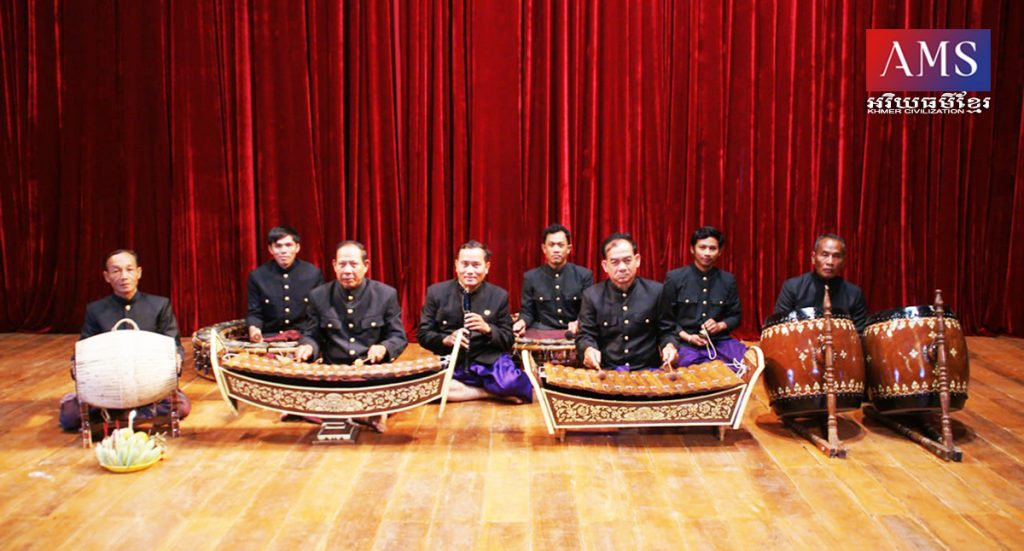ពាក្យ “គង” ជាលក្ខណៈនៃក្រុមទាំងមូល សំដៅទៅលើឧបករណ៍គ្រឿងដំ រួមមានគងញី (គងដោះ) គងឈ្មោល (គងរាបឬគងសំប៉ែត) គងតូច គងធំ គងវង់តូច និងគងវង់ធំ។ “គងវង់” សំដៅលើគងតូចនិងគងធំ មានដើមកំណើតនិងអភិវឌ្ឍន៍មកពីឧបករណ៍តន្ត្រី “ពាទ្យ”ដែលមានរូបចម្លាក់ឆ្លាក់នៅលើជញ្ជាំងប្រាសាទអង្គរវត្ត(ថែវខាងជើង) នាសតវត្សទី១២។ ឧបករណ៍ពាទ្យជាឧបករណ៍តន្ត្រីដើមដែលផ្តល់កំណើតនិងអភិវឌ្ឍន៍ដល់គងតូចនិងគងធំប្រើនៅក្នុងវង់តន្ត្រីពិណពាទ្យសព្វថ្ងៃ។
គងវង់តូច មានផ្លែ១៨និងគងវង់ធំ មានផ្លែ១៦ ប្រើនៅក្នុងវង់តន្ត្រីពិណពាទ្យដែលរួមជាមួយនឹងឧបករណ៍តន្ត្រីឯទៀត មានស្រឡៃ រនាតឯក រនាតដែក រនាតធុង សម្ភោរ ស្គរធំ និងឈឹង។ គេរៀបផ្លែគងតូចនិងគងធំពីឆ្វេងទៅស្តាំ ពីសូរទាបទៅខ្ពស់ នៅក្នុងរង្វង់រាងមូលធ្វើពីផ្តៅដំបង។ គេចងផ្លែគងនីមួយៗដោយប្រើចម្រៀកស្បែកគោធ្វើជាខ្សែភ្ជាប់ទៅនឹងរង្វង់គងដែលធ្វើពីផ្តៅនោះ។
ផ្លែគងមានរាងដូចផ្តិលនិងមានដោះប៉ោងឡើងនៅចំកណ្តាលផ្លែ ជាកន្លែងដែលអ្នកលេងវាយនឹងអន្លូង។ គេសិតផ្លែគងពីសំរឹទ្ធលាយនឹងលង្ហិន។ អន្លូងគងធ្វើពីស្បែកដំរីឬស្បែកក្របី កាត់ជាថាសមូលតូចហើយចោះរន្ធនៅចំកណ្តាលដើម្បីស៊កដងធ្វើពីឈើសម្រាប់អ្នកលេងកាន់វាយគង។ ដើម្បីឱ្យត្រូវសូរដែលចង់បាន គេធៀបផ្លែគងដោយប្រើប្រមរបិទនៅក្នុងដោះគងនោះ។
ផ្លែគងតូច មានទំហំប្រមាណ ១៣,៥០ស.ម. – ១៤ស.ម.
ផ្លែគងធំ មានទំហំប្រមាណ ១៦,៥០ស.ម. – ១៨,៥០ស.ម.
ផ្លែគងធុង មានទំហំប្រមាណ ២០ស.ម. – ២២ស.ម. ការបាត់បង់ឬឈប់ប្រើគងវង់ធុងនៅកម្ពុជា ជារឿងមួយដែលយើងសោកស្តាយពេកណាស់។ នេះជាកត្តាមួយដែលយើងអាចយកជាឧទាហរណ៍ថា បើយើងមិនប្រើវាទេ យើងនឹងបាត់បង់កេរដំណែលដូនតាខ្មែរ ដែលជាកាតព្វកិច្ចរបស់យើងត្រូវថែរក្សា។ ក៏ដូចជាទម្រង់សិល្បៈមួយចំនួនដែលបានបាត់បង់មួយរយៈដែរ ដោយសារស្មារតី ការយកចិត្តទុកដាក់និងការខិតខំប្រឹងប្រែងរបស់យើង យើងបានធ្វើឲ្យទម្រង់ទាំងនោះបានរស់រានមានជីវិតឡើងវិញ មានជាអាទិ៖ ល្ខោនអាប៉េ ល្ខោនប្រាមោជ្ជទ័យ ល្ខោនពោលស្រី ល្ខោនគែន ល្ខោនភ្លេងការ ល្ខោនស្បែកពណ៌ និងឧបករណ៍តន្ត្រីពិណ ជាដើម។ល។
———————————————–
Korng Vung
The Khmer word “korng” (gong) generically refers to all types of gong, be it flat or bossed, single or set, hung on hooks or suspended over rattan frames, namely, korng nhi or korng dah (single knobbed gong), korng chhmol (single flat gong), korng tauch (small gong), korng thomm (large gong), korng vung tauch (high-pitched circular-framed gong), and korng vung thomm (low-pitched circular-framed gongs). Organologically speaking, “korng vung” or circular-framed gongs are struck idiophones, believed to be developed from the Khmer musical instrument called peat, which was carved on the north gallery of the 12th century Angkor Wat temple.
The history and development of Khmer gongs are obvious, more so than other Khmer musical instruments attested by the old Khmer epigraphy and iconography of the Funan-Chenla and Angkor periods (Sam 2002: 73). Many of them were carved on the stone walls of the ancient Khmer temples. Among many Khmer indigenous ethnic groups inhabiting the high lands and hilly plateau of northeast Cambodia, several types of gong are used until the present day as predominant musical instruments.
The standard korng vung tauch has 18 small knobbed gongs, and the korng vung thomm has 16 suspended over rattan frames. The former is measured approximately 112 cm (44 inches) and the latter 122 cm (48 inches) from side to side. It should be noted that the differences between the two circular-framed gongs lie in the number of gongs, size of the knobbed gongs and frames, one is smaller than the other, and thus, higher in pitch. The two circular-framed gongs are used mainly in the pinn peat ensemble to accompany Khmer court dance and religious ceremonies. The korng vung tauch is used only in the full or large instrumentation of pinn peat, and not in the reduced instrumentation of only five instruments, namely, roneat aek, korng vung thomm, sralai thomm, sampho, and skor thomm. From their ancestor peat, the present-day Khmer circular-framed gongs—korng vung tauch and korng vung thomm were born.
អត្ថបទដើម៖ បណ្ឌិត សំ សំអាង







